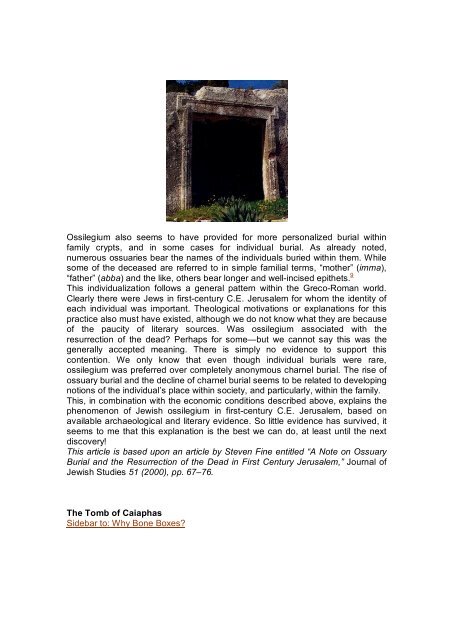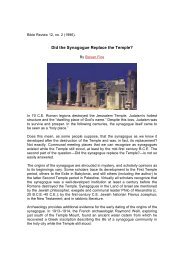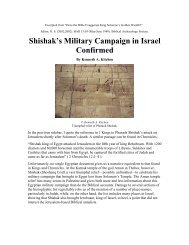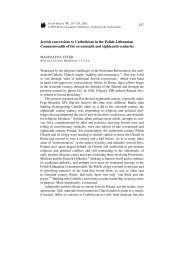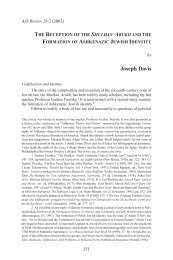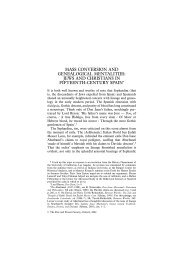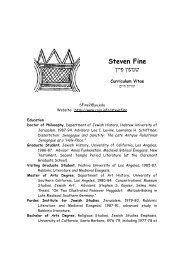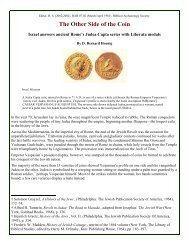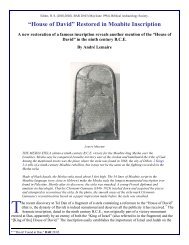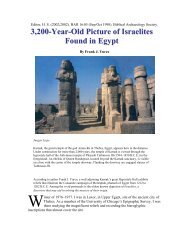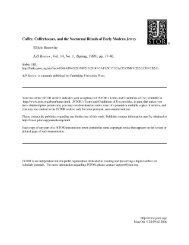Why Bone Boxes? Splendor of Herodian Jerusalem reflected in ...
Why Bone Boxes? Splendor of Herodian Jerusalem reflected in ...
Why Bone Boxes? Splendor of Herodian Jerusalem reflected in ...
Create successful ePaper yourself
Turn your PDF publications into a flip-book with our unique Google optimized e-Paper software.
Ossilegium also seems to have provided for more personalized burial with<strong>in</strong><br />
family crypts, and <strong>in</strong> some cases for <strong>in</strong>dividual burial. As already noted,<br />
numerous ossuaries bear the names <strong>of</strong> the <strong>in</strong>dividuals buried with<strong>in</strong> them. While<br />
some <strong>of</strong> the deceased are referred to <strong>in</strong> simple familial terms, “mother” (imma),<br />
“father” (abba) and the like, others bear longer and well<strong>in</strong>cised epithets. 9<br />
This <strong>in</strong>dividualization follows a general pattern with<strong>in</strong> the GrecoRoman world.<br />
Clearly there were Jews <strong>in</strong> firstcentury C.E. <strong>Jerusalem</strong> for whom the identity <strong>of</strong><br />
each <strong>in</strong>dividual was important. Theological motivations or explanations for this<br />
practice also must have existed, although we do not know what they are because<br />
<strong>of</strong> the paucity <strong>of</strong> literary sources. Was ossilegium associated with the<br />
resurrection <strong>of</strong> the dead? Perhaps for some—but we cannot say this was the<br />
generally accepted mean<strong>in</strong>g. There is simply no evidence to support this<br />
contention. We only know that even though <strong>in</strong>dividual burials were rare,<br />
ossilegium was preferred over completely anonymous charnel burial. The rise <strong>of</strong><br />
ossuary burial and the decl<strong>in</strong>e <strong>of</strong> charnel burial seems to be related to develop<strong>in</strong>g<br />
notions <strong>of</strong> the <strong>in</strong>dividual’s place with<strong>in</strong> society, and particularly, with<strong>in</strong> the family.<br />
This, <strong>in</strong> comb<strong>in</strong>ation with the economic conditions described above, expla<strong>in</strong>s the<br />
phenomenon <strong>of</strong> Jewish ossilegium <strong>in</strong> firstcentury C.E. <strong>Jerusalem</strong>, based on<br />
available archaeological and literary evidence. So little evidence has survived, it<br />
seems to me that this explanation is the best we can do, at least until the next<br />
discovery!<br />
This article is based upon an article by Steven F<strong>in</strong>e entitled “A Note on Ossuary<br />
Burial and the Resurrection <strong>of</strong> the Dead <strong>in</strong> First Century <strong>Jerusalem</strong>,” Journal <strong>of</strong><br />
Jewish Studies 51 (2000), pp. 67–76.<br />
The Tomb <strong>of</strong> Caiaphas<br />
Sidebar to: <strong>Why</strong> <strong>Bone</strong> <strong>Boxes</strong>?


